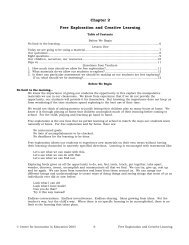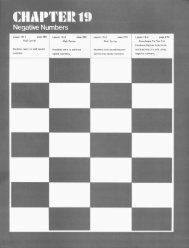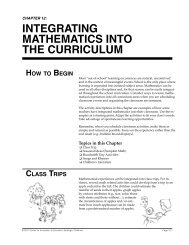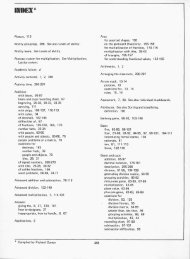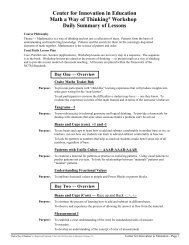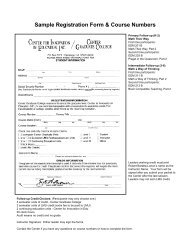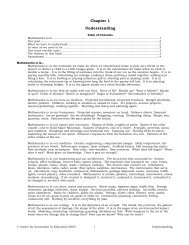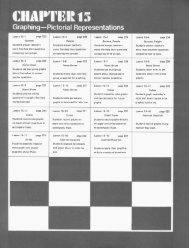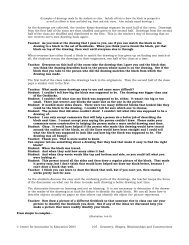Chapter 11 Fractions, Ratios, Money, Decimals and Percent
Chapter 11 Fractions, Ratios, Money, Decimals and Percent
Chapter 11 Fractions, Ratios, Money, Decimals and Percent
You also want an ePaper? Increase the reach of your titles
YUMPU automatically turns print PDFs into web optimized ePapers that Google loves.
Rate tables .........................................................................................................................267Lesson TenFocus on an underst<strong>and</strong>ing ................................................................................................268One is what we say it is, again............................................................................................268Where the decimal goes....................................................... ...............................................269New equivalencies..............................................................................................................270A rule for multiplying..........................................................................................................270What the answers mean......................................................................................................271Ten by ten.................. ........................................................................................................272Lesson ElevenNot equivalent ....................................................................................................................273The difference ....................................................................................................................2743Calculator key.................................................... ................................................................274Knowledge we can refine.....................................................................................................274Lesson TwelveFast finishers.....................................................................................................................276Vending machine......................................................................................................... .......277Do we know to teach the parents? .......................................................................................277Milk money ........................................................................................................................278Restaurant lunch................................................................................................................278Stores ........................................................... .....................................................................279Think money ......................................................................................................................279Assessments ......................................................................................................................280SummaryTwelve lessons ...................................................................................... .............................280Questions from Teachers1. How do we assess for fractions? What kind of assessments might we use? .....................2802. In Lesson Ten, for the multiplication problems on the geoboard, the fractions in the answerswere not reduced. Why not? Isn't the teaching of the reducing of fractions an extension ofequivalencies?..............................................................................................................281<strong>Fractions</strong>...<strong>Fractions</strong> are:Before We BeginAreas of shapes.Parts of groups.<strong>Money</strong>'s change.<strong>Ratios</strong> of numbers.<strong>Decimals</strong>.Fragments.Equal shares.Measurements of time.Partial lengths, weights, or heights.Costs per unit sold.Averages.<strong>Percent</strong>s.Portions.Numbers waiting to divide.Parent speaking to two children about to share a single piece of cake: One of you can cut thepiece of cake; the other one can choose his piece first.Children are familiar with fractions long before they come to school. How carefully will the cutter cutthe cake? Do the children dividing the cake know the piece each one receives is called a half? Is thereany question that the child doing the cutting <strong>and</strong> the child choosing first underst<strong>and</strong> the meaning ofdividing evenly?<strong>Fractions</strong> are a part of children's lives before children even know that fractions are a part of math. Ourhope is that the lessons that we teach leave our students as comfortable with fractions as our studentswere before our lessons began.Guides <strong>and</strong> nothing more..."Lift the Bowl" is a game in Mathematics Their Way (pages 181-183) in which the first player selects abeginning number of blocks. This first player then hides some of the blocks beneath the bowl <strong>and</strong> putsthe rest on top. The second player, when told the beginning number, looks at the blocks on top <strong>and</strong>says how many blocks are hidden. For the illustration below, five blocks is the starting number.(illustration <strong>11</strong>-0-1)(A bowl from the bowl game with three blocks on top.)© Center for Innovation in Education 2003 240 <strong>Fractions</strong>, <strong>Ratios</strong>, <strong>Money</strong>, <strong>Decimals</strong> <strong>and</strong> <strong>Percent</strong>




